Mods to Transmute Into Continuity Warframe
Quick Links
- What Are Mods?
- Installing A Mod
- Mod Drain And Polarities
- Upgrading Mods And Endo
- Obtaining Mods
- Modding Warframes
- Modding Weapons
- Mod Rarities And Types
- Transmutation
- Mandatory Mods
Warframe features some of the most extensive customization options out of any shooter. Players can augment every aspect of their Warframes and guns, ranging from cosmetics to how they behave in-game. The latter is handled almost exclusively through the game's Mod system.
Modding your gear is a crucial skill to learn if you want to get anywhere in Warframe. Unfortunately, the tutorial doesn't do the best job of explaining what Mods are and how they work. That's what this guide is here to solve. We'll be going over every aspect of modding, covering the basics of Mods, how to install Mods on your gear, breaking down how modding works for each item type, and we'll close off by recommending some Mods that new players should focus on getting.
What Are Mods?
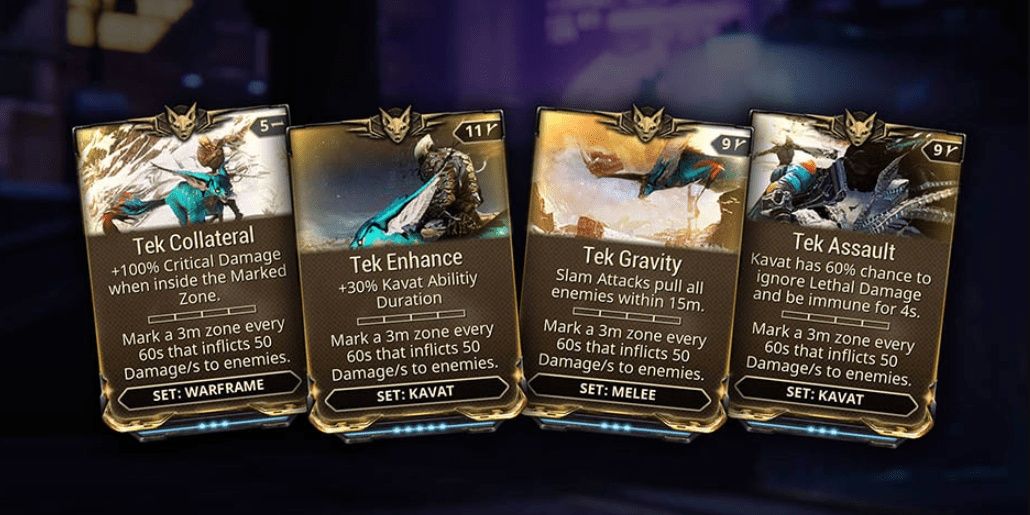
Mods are unique cards that can be socketed into your Warframes, weapons, and companions to enhance their capabilities. Mods allow you to increase the damage of your abilities, multiply the number of bullets your weapons fire, or even augment the way your Warframe powers work. Mods have infinite uses, can be applied to all supported items without needing duplicates, and can be traded with other players. This is your primary method of improving your Warframes and weapons, so be sure you fully understand and utilize this system.
What Makes Up A Mod Card
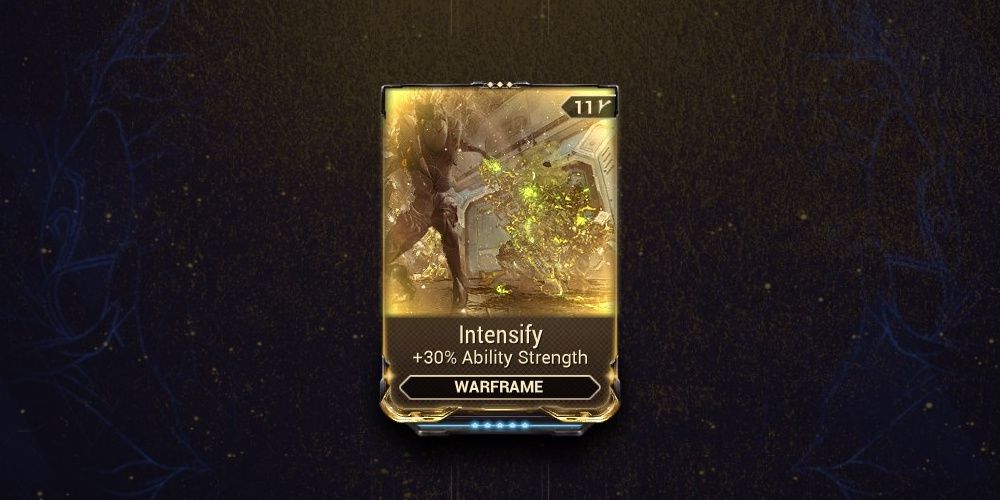
Mods are comprised of the following attributes:
- Name: Self-explanatory.
- Effect: What the Mod does. Some Mods have multiple effects and even set bonuses (explained later).
- Slot: Which equipment can use that Mod.
- Rank: The level of your Mod. Higher ranked Mods have a stronger effect but a higher Mod drain.
- Mod Drain: The energy drain associated with socketing the Mod into a piece of gear.
- Mod Polarity: A symbol on the top-right of the Mod, Polarities allow you to halve a Mod's drain if slotted in a matching symbol.
If some of those terms don't make sense, don't worry. We'll be covering each aspect of a Mod more in-depth through the next few sections. For now, just know that Mods buff your equipment. We'll cover some good starter and endgame Mods near the end of the guide (or you can click here to jump straight to that section).
Return to Quick Links
Installing A Mod
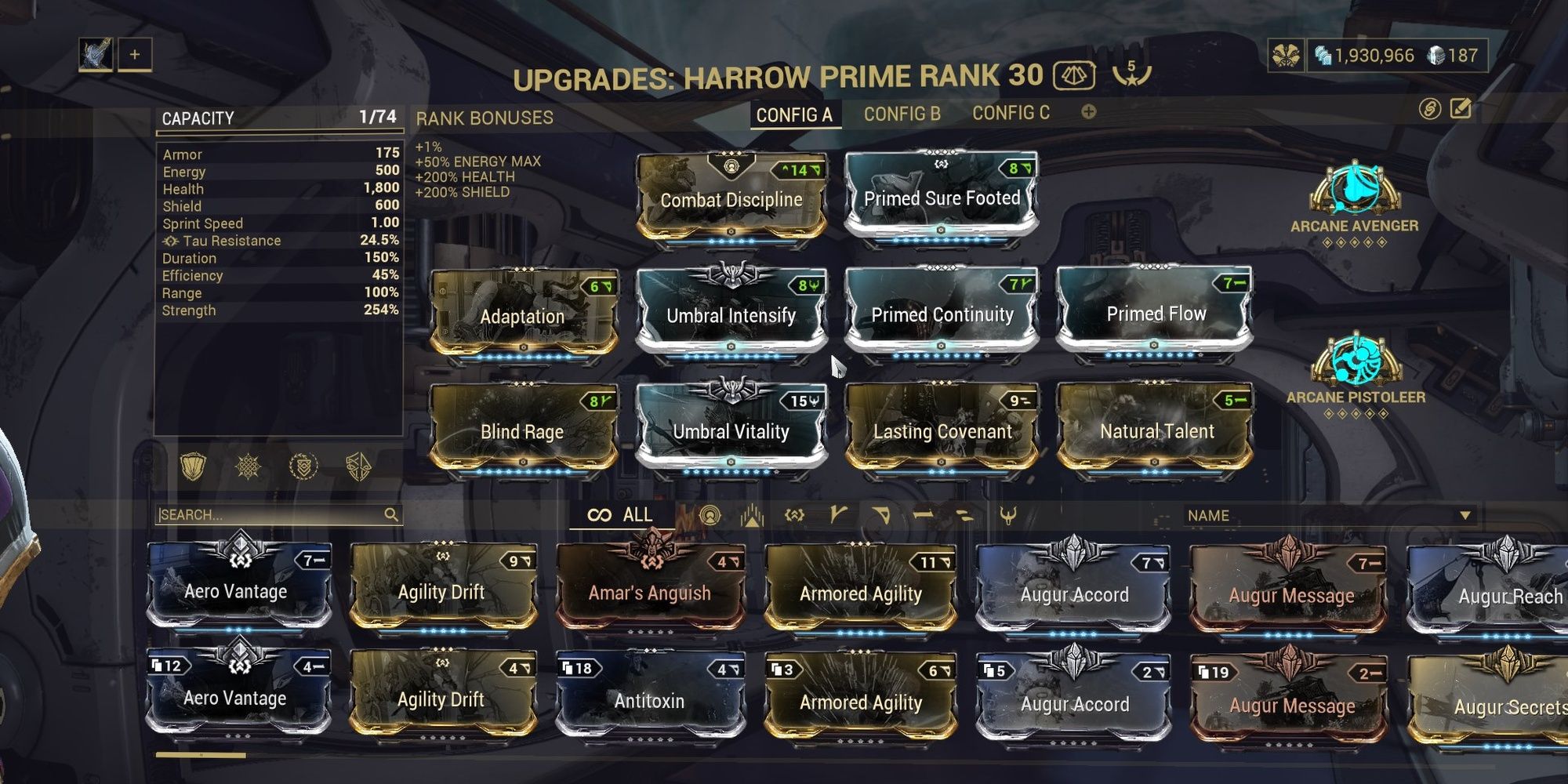
Installing a Mod is a straightforward task:
- Head to your Arsenal.
- You can also reach it by entering the main menu -> Equipment -> Arsenal
- Hover over the item you wish to upgrade.
- Select "Upgrade."
- You'll now be in a menu with an empty grid and numbers. Look for a Mod at the very bottom of your screen.
- Drag it into an empty Mod slot.
Congratulations, you just installed a Mod. Despite how complicated the modding menu looks, getting Mods installed on your gear is very easy.
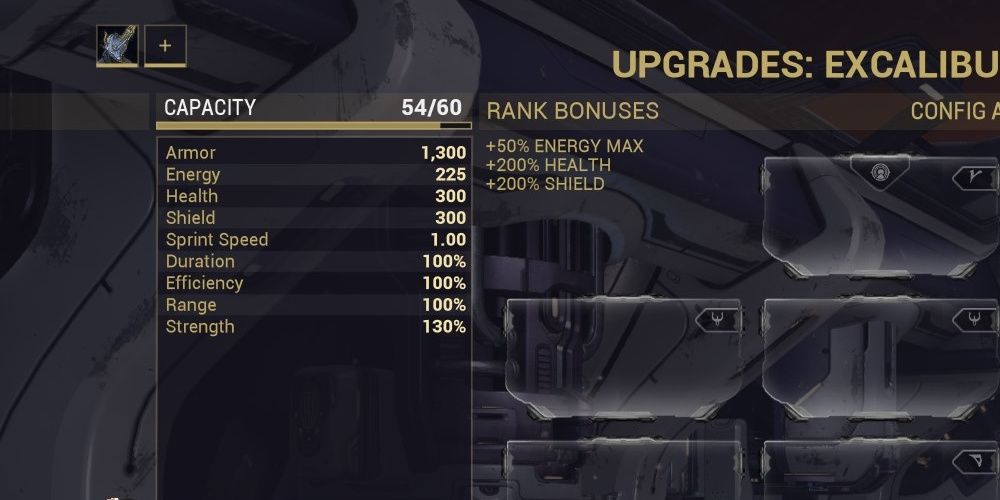
You might have noticed that installing the Mod dropped a number at the very top-left of your screen. This is called your Mod capacity. Items in Warframe can only install so many Mods before their capacity reaches its limit. You can increase your item's capacity through the following:
- Leveling The Item – One level equals one extra Mod capacity, two if an Orokin Reactor or Catalyst is installed.
- Most items have a level cap of 30.
- Installing An Orokin Catalyst/Reactor – Orokin Catalysts double a weapon's capacity. Reactors double the capacity of a Warframe, vehicle, or companion.
- These can be obtained from Nightwave rewards—Warframe's free Battle Pass.
Return to Quick Links
Mod Drain And Polarities
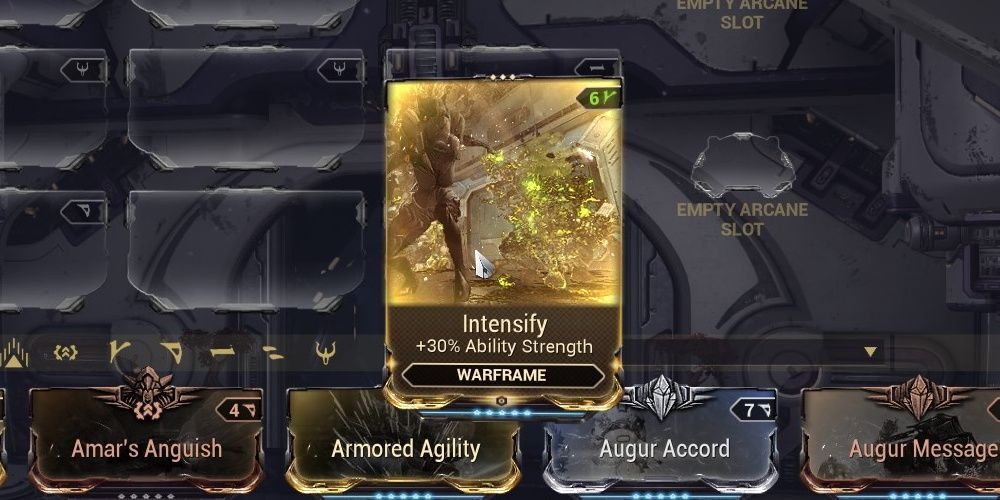
One of the most confusing aspects of modding is the Polarity system. You might have seen a Mod that has a strange symbol in the top-right of the card. This is called a Polarity. Polarities are symbols found on Mod cards and Mod slots on your gear.
Matching a Mod's Polarity with a Mod slot's Polarity will halve the cost of the Mod. Conversely, slotting a Mod with a different Polarity than the slot will increase the Mod's drain by 25%. That might sound confusing, so let's give an example. Let's say you want to install the Intensify Mod onto your Warframe. You have three empty slots. One slot is blank, one has a "D" symbol, and the third slot has a "V" symbol.
Socketing the Intensify in the blank Mod slot will drain 11 points from your build, Intensify's standard drain amount. Moving it to the V socket will halve the drain, reducing it to 6 points (the game rounds up). Conversely, moving it to the D socket will increase Intensify's cost by 25%, raising it from 11 to 14.
As you can see, matching Polarities can drastically reduce the Mod drain in your build, allowing you to socket even more Mods to enhance the strength of your equipment. Be sure to match Polarity symbols whenever possible to get the most out of your builds.
Adding Polarities Onto Items
Once you've leveled an item to its max rank, you can Polorize it by using a built Forma to add a Polarity of your choice onto any Mod slot. This will reset the rank of your item, but you'll have a new Polarity on the item to utilize. Forma is a rare resource that is a potential Void Relic reward. Applying Forma onto your items will let you fit more expensive Mods into your build, increasing your loadout's overall effectiveness.
All Polarity Symbols
There are eight types of Polarities in Warframe, although only the first four see frequent use. Credit to the Warframe Fandom Wiki for the images used in the following table:
Note: Umbral, Unairu, Penjaga, and Aura Polarities are seldom used.
Return to Quick Links
Upgrading Mods And Endo
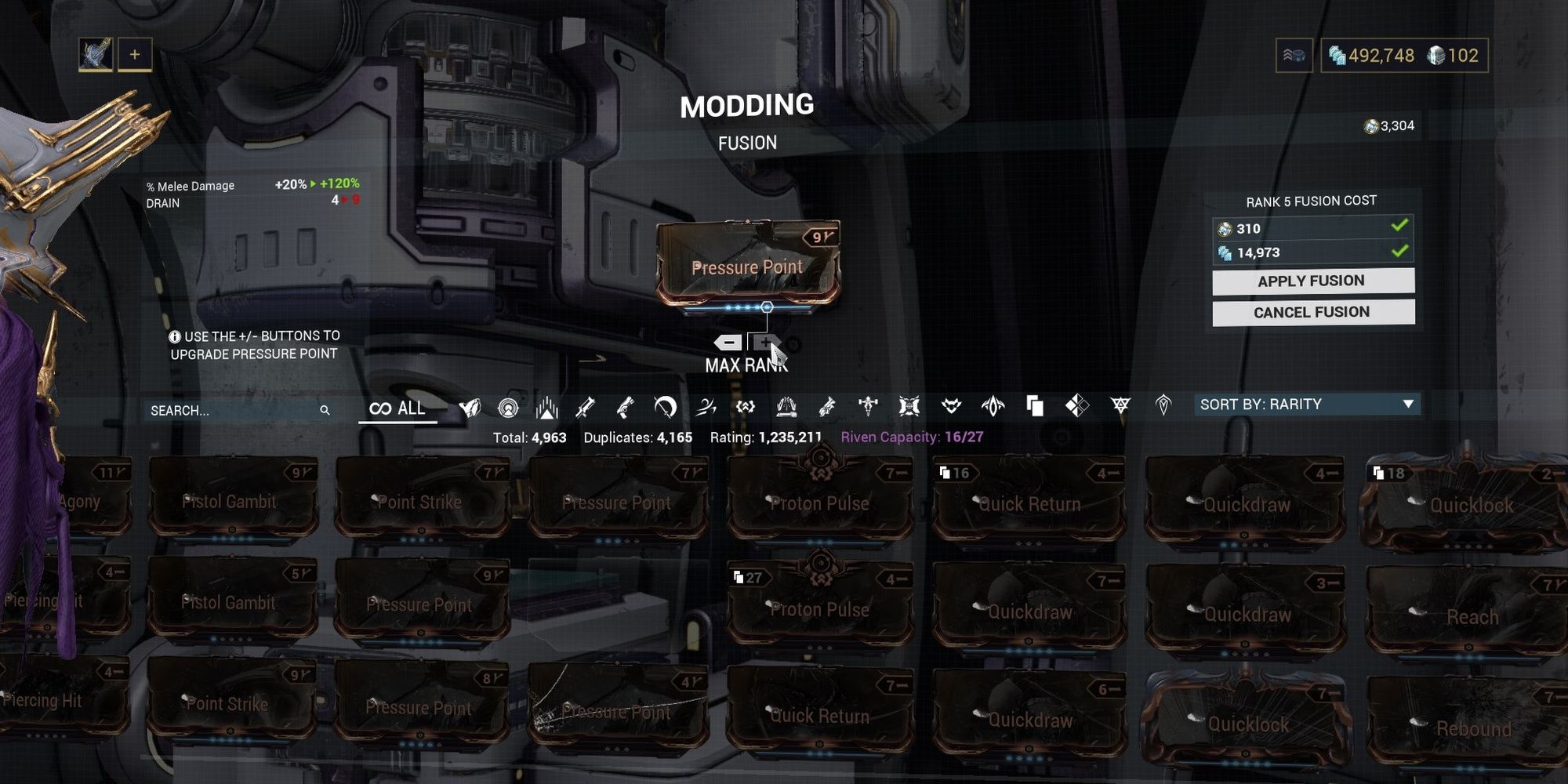
Similar to Warframes and weapons, Mods have levels that dictate their effectiveness. You can increase a Mod's rank by investing Credits and Endo, two core resources you'll stumble across while playing Warframe. Increasing a Mod's level will raise all of its stats by set increments while increasing its Mod Drain by one per rank. In simple terms, making your Mods stronger will also make them more expensive to install.
Upgrading A Mod Through Fusion
Upgrading a Mod isn't much harder than installing one. Here's the process:
- Head to the "Mods" station in your ship.
- You can also reach it by entering the main menu -> Equipment -> Mods
- Select the Mod you wish to upgrade.
- Select the "Fusion" option at the top left of the screen.
- Use the arrow keys under the Mod to increase its rank to the desired amount.
- Select "Apply Fusion."
- This will cost a certain amount of Endo and Credits.
That's all there is to upgrading Mods. Of course, there's one major question we still need to answer: what's Endo?
What's Endo?
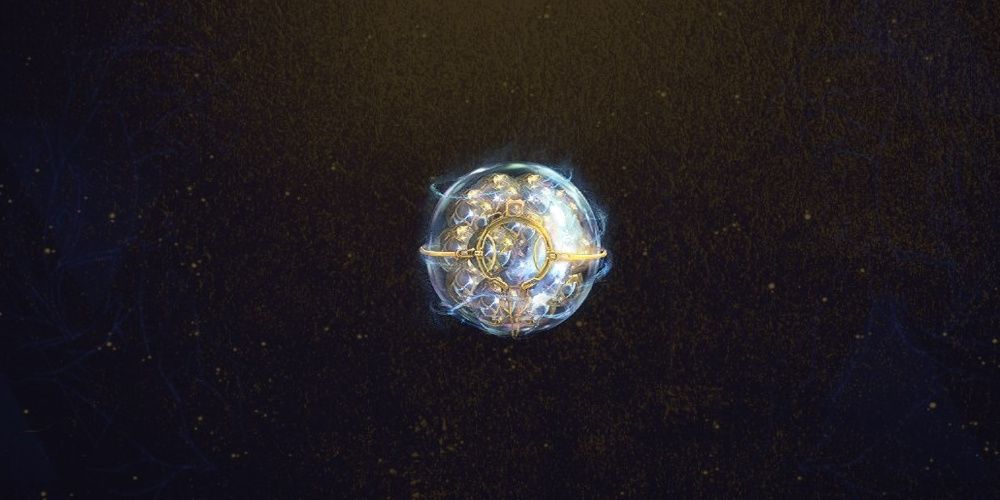
Endo is a currency used in upgrading your Mods. This resource drops from the following:
- Slain enemies (rare drop)
- Certain mission rewards
- Ayatan Treasures
- Dismantling spare Mods
- Potential Login reward
You'll earn a little bit of Endo from playing Warframe, but your primary source of Endo in the early game is going to be from Ayatan Treasures. These golden statues can be dismantled into raw Endo at Maroo's Bazaar—a hub area located on Mars. Every statue also has sockets that accept Ayatan Stars—a small item that has a rare chance of spawning from opened lockers and crates. Fill your statues with Ayatan Stars whenever you can to maximize their Endo value. You can upgrade your treasures from the "Mods" menu under the "Ayatan Treasures" tab at the top-right of the menu.
Maroo also has a weekly that guarantees an Ayatan Treasure upon completion. Speak with her at Maroo's Bazaar to start the weekly. Run this mission whenever you can to earn a steady stream of Endo.
Mod Upgrading Costs
The rarity of Mod and total ranks will dictate how expensive the Mod is to maximize. In general, the cost of upgrading a Mod doubles with each rank. This makes Mods with ten ranks much harder to max than Mods with just five. We recommend you max any Mods with five or fewer ranks, but don't fully upgrade Mods with ten ranks unless you have tens of thousands of Endo. Leaving those Mods at rank eight or nine is more than enough.
Upgrade costs for all Mod types are listed below, sorted by Mod rarity:
Rarity(Rank) | Endo Cost | Credit Cost |
|---|---|---|
Common(5 Ranks) | 310 | 14,973 |
Uncommon(5 Ranks) | 620 | 29,946 |
Rare(5 Ranks) | 930 | 44,919 |
Common(10 Ranks) | 10,230 | 494,109 |
Uncommon(10 Ranks) | 20,460 | 988,218 |
Rare(10 Ranks) | 30,690 | 1,482,327 |
Legendary(10 Ranks) | 40,920 | 1,976,436 |
Return to Quick Links
Obtaining Mods
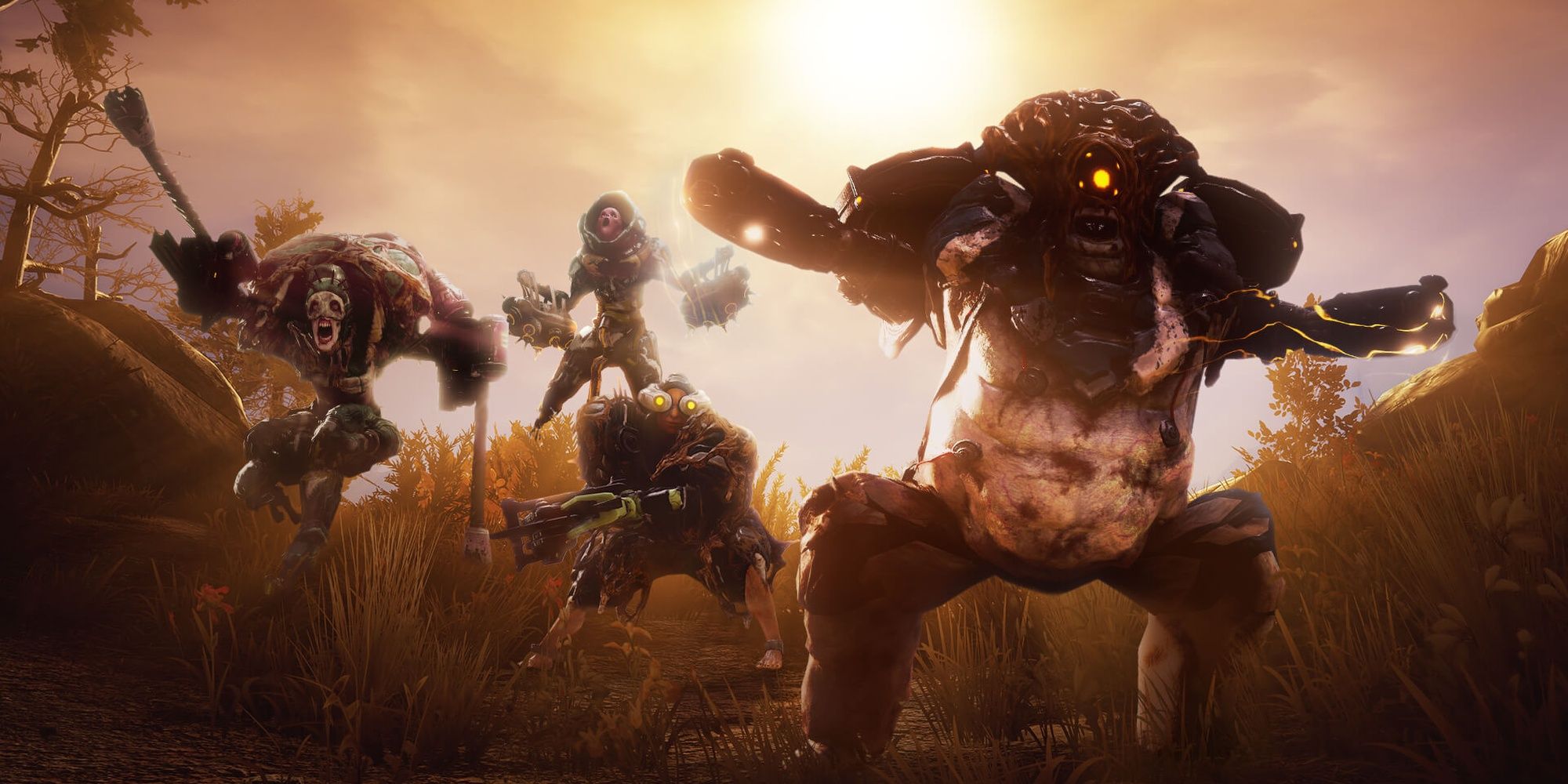
Mods drop from just about every enemy in Warframe. Most enemies have a 3% chance of dropping a Mod when slain, give or take. Beyond killing enemies, you can obtain Mods as mission rewards or from in-game vendors like Syndicates. Trading Mods with other players is also possible if you're looking for something specific.
One of the best ways of obtaining Mods early on is by breaking Void Canisters in the Void tileset. Certain rooms act as parkour tests that reward you with a room filled with unique canisters. These canisters have a very high chance of dropping a Mod, some of which are quite rare. Maroo's weekly missions usually take place in one of these rooms, giving you further incentives to complete her weekly whenever it's available.
Additionally, we want to give a special mention to Aura and Stance Mods since they give your items Mod capacity instead of draining it. You can obtain Aura Mods by spending Nightwave Creds in the Nightwave menu found in your ship or Navigation menu. Stance Mods drop from certain enemies and activities. We'll talk more about good Mods to farm for near the end of the guide.
Return to Quick Links
Modding Warframes
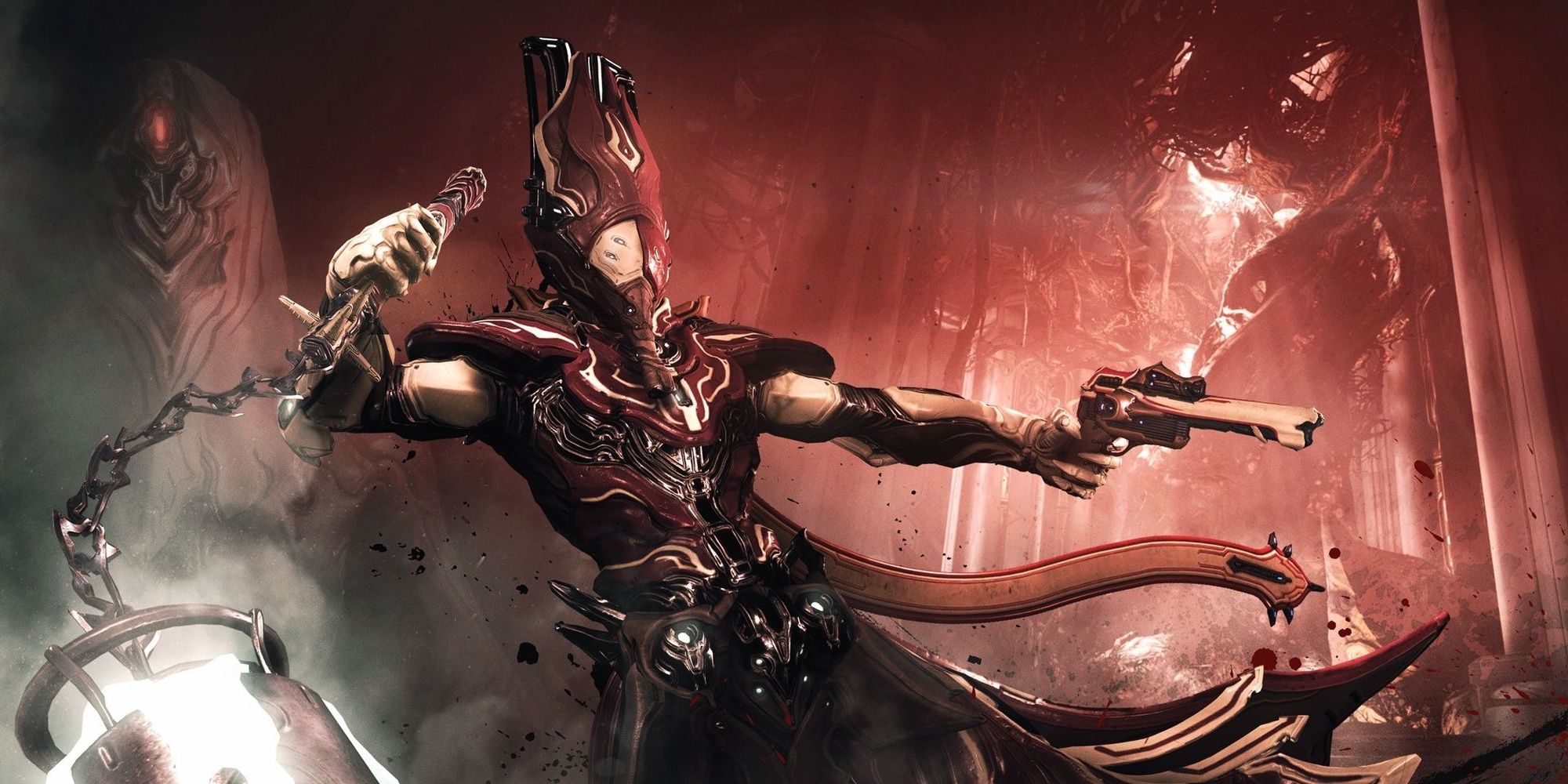
Warframes feature ten Mod slots, two of which can only install certain Mods. Your Warframe's stats revolve around improving its survivability, speed, and how effective its abilities are.
Warframe Mod Slots
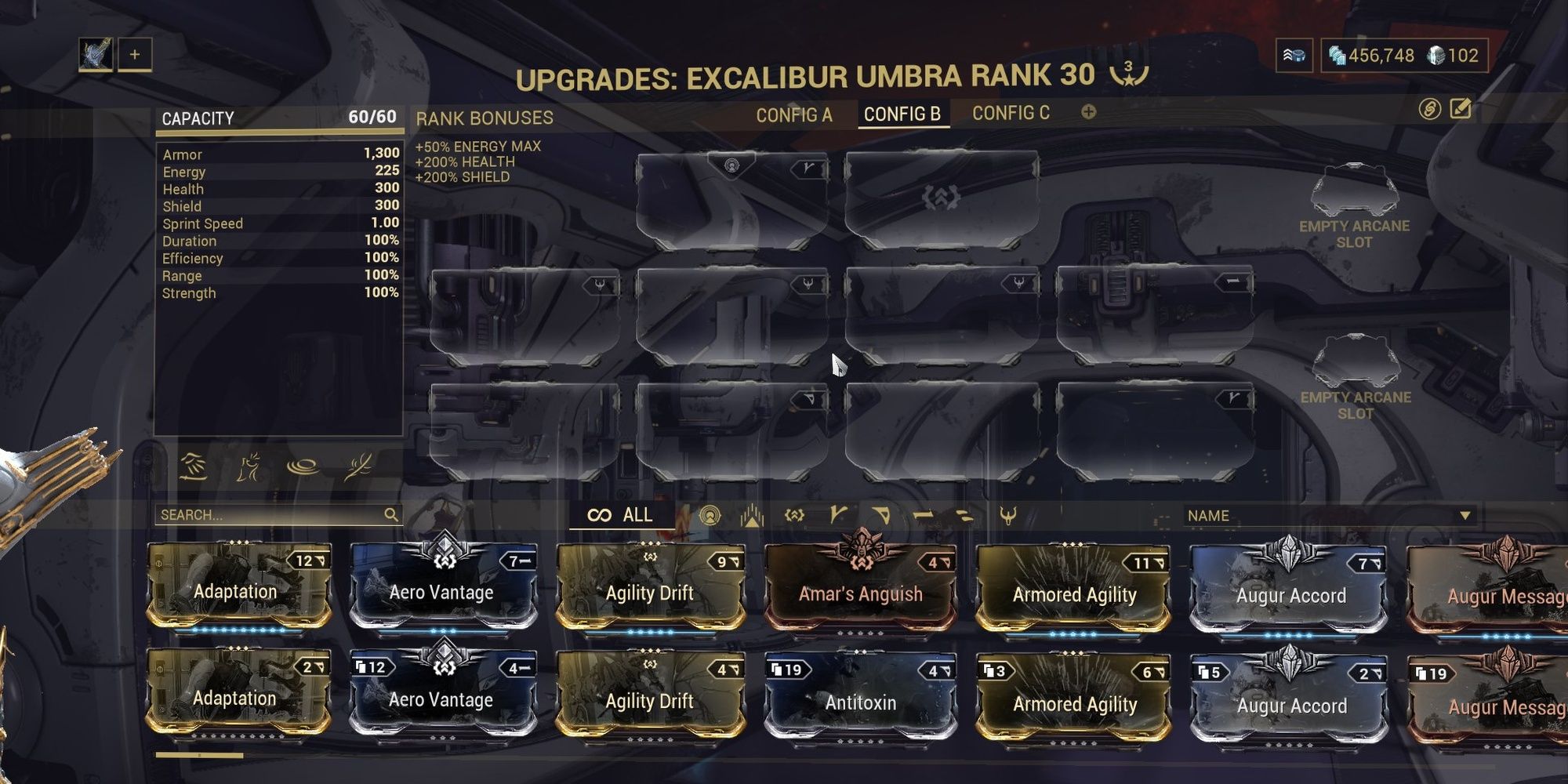
| Aura Slot | Exilus Slot | ||
|---|---|---|---|
| Default Slot | Default Slot | Default Slot | Default Slot |
| Default Slot | Default Slot | Default Slot | Default Slot |
- Aura Slot – Houses Mods that affect your team, not just you. These Mods grant Mod capacity.
- Exilus Slot – Compatible with certain utility Mods, denoted with a unique symbol (a set of brackets enclosing nested carets).
- Locked by default, but can be accessed by installing an Exilus Adapter.
- Default Slot – Houses all non-Aura Mods, including Augment Mods. These slots mainly impact your abilities and survivability.
Warframes have ten slots to work with, eight of which focus on enhancing your character's survivability and ability effectiveness. Increasing your Mod capacity with a Warframe requires an Orokin Reactor.
Warframe Stats
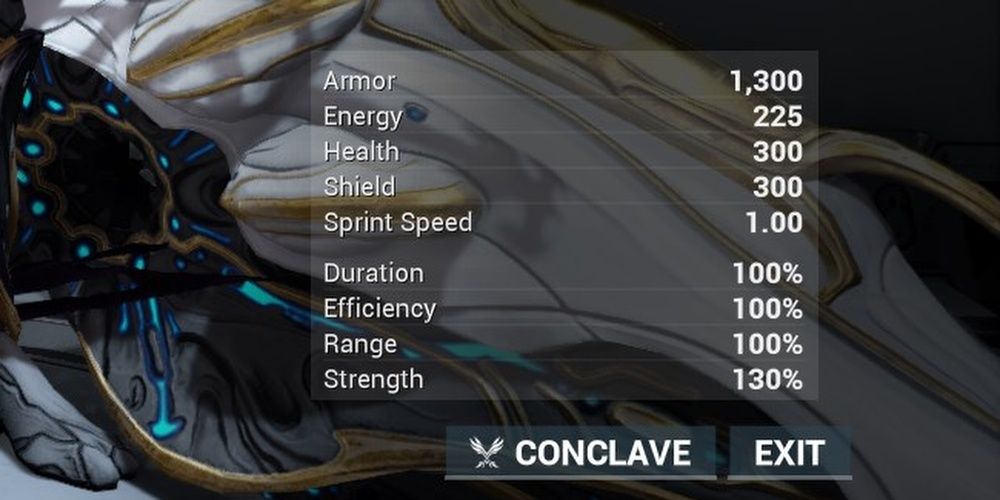
Warframes have two sets of stats: abilities and passive stats. Ability stats govern how effective your abilities are, while passive stats impact your survivability, speed, and any utility your Warframe might benefit from. Let's start with abilities:
- Ability Duration – Determines how long your abilities last. It also impacts the Energy drain of certain channeled abilities (explained below).
- Ability Efficiency – Determines how much Energy your abilities drain, both channeled and non-channeled skills. Has a hard cap of 175%.
- Ability Range – Determines the distance each ability can cover, if applicable. This impacts a projectile's maximum range, the radius of certain skills, and the cone angle of some cone-based AoE skills.
- Ability Strength – Determines the magnitude of your ability's benefits. Examples include ability damage, buff strength, or how much a skill debuffs a target.
In general, most Warframes want to increase their Ability Strength and Efficiency. Strength will make most abilities more potent, while Efficiency will let you cast your abilities more often.
Your Warframe also has some general stats that determine how durable and speedy it is:
- Armor – Reduces damage taken to your health, not shields.
- Energy – Determines how much ability Energy your Warframe can store at any given moment.
- Health – Affects your Warframe's total HP. If it reaches zero, you die.
- Shields – Affects your Warframe's shields, a second health source that takes damage before your health.
- Sprint Speed – Determines how fast your Warframe moves while sprinting.
Not explicitly mentioned in-game, shields regenerate. Health does not. However, armor only affects your health. If you're new to Warframe, it's safe to spec for shields early on. When you obtain methods of healing yourself, speccing for health is generally recommended unless you're using advanced strategies like shield gating (something we won't cover in this guide).
The Relationship Between Ability Duration And Efficiency For Channeled Skills

If you're completely new to Warframe, skip this section.
It's worth noting that Efficiency has a unique relationship with Duration when it comes to channeled skills—abilities that last until you toggle them off or run out of Energy. In essence, channeled abilities drain Energy at a specific rate per second. Increasing your Duration will reduce how often Energy is drained. The inverse is also true: reducing your Duration will cause Energy to drain more quickly.
This still has to abide by the Efficiency cap of 175%, meaning you can't stack Efficiency and Duration to get an ability that drains no Energy. You can trade some Efficiency for Duration to achieve the 175% cap and vice versa, but do bear in mind that this conversion is not one-to-one; Efficiency is far more valuable for reducing a channeled ability's drain per second than Duration.
All of that to say, to achieve a true 75% Energy cost reduction for channeled skills, ensure that your Duration is 100%. Overcapping your Efficiency can let you drop your Duration below 100% and vice versa.
Return to Quick Links
Modding Weapons
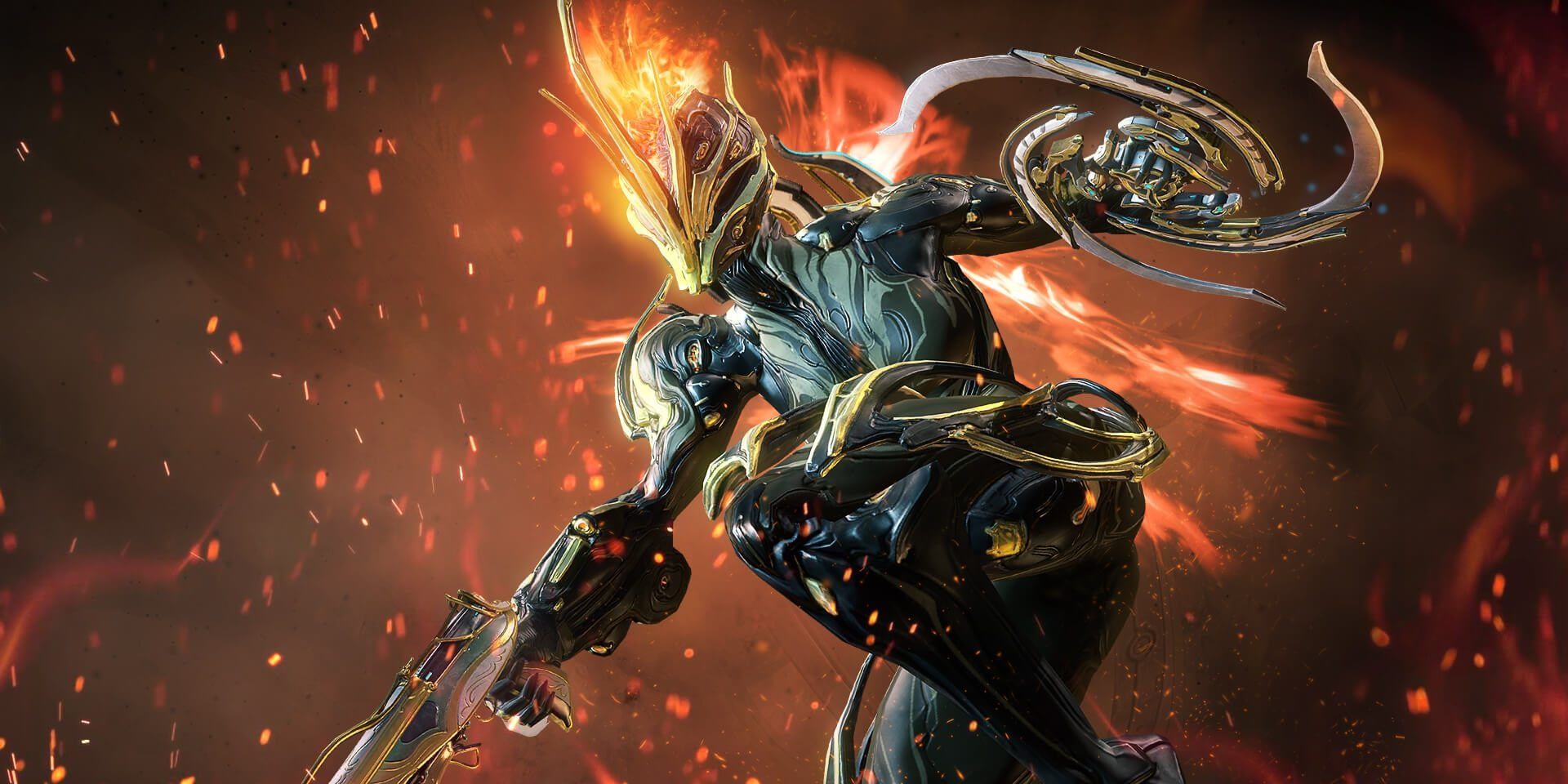
Modding your weapons is critical to getting through Warframe's early to mid-game. Let's go over what you'll want to focus on when modding your weapons.
Weapon Mod Slots

| Default Slot | Default Slot | Default Slot | Default Slot | Exilus Slot |
| Default Slot | Default Slot | Default Slot | Default Slot |
- Exilus Slot – Compatible with certain utility Mods, denoted with a unique symbol (a set of brackets enclosing nested carets).
- Locked by default, but can be accessed by installing a Primary/Secondary Exilus Adapter.
- Default Slot – Houses all weapon Mods, allowing you to increase your DPS in various ways.
There are no Aura Mods for weapons. You have eight default slots and a single Exilus slot, the Exilus slot requiring an adapter to fully unlock. Weapons require an Orokin Catalyst to enhance their capacity.
Weapon Stats
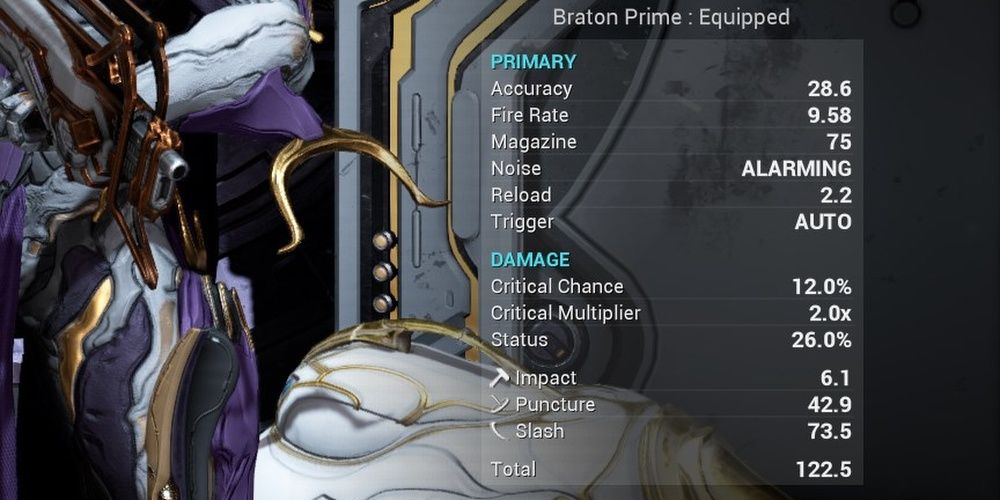
Similar to Warframes, weapon stats are split into two categories: primary and damage. Primary includes all of your weapon's auxiliary stats and how fast it fires. Damage stats are all about how hard your bullets hit.
Let's start with primary stats:
- Accuracy – How far projectiles deviate from the center of your reticle. Higher is better.
- Falloff – The distance your projectiles can travel before they experience damage falloff. This only affects shotguns.
- Fire Rate – How quickly your weapon fires each second. Semi-auto weapons can't shoot faster than ten rounds per second.
- Magazine – How many rounds you can fire before needing to reload
- Multishot – The number of projectiles fired with each trigger pull
- Noise – Determines if enemies will be alerted to you firing your gun and from how far.
- Reload – How quickly your weapon reloads.
- Trigger – How your weapon behaves when shot. Semi, burst, auto, charge, and held are the most common.
You'll only want to worry about your weapon's fire rate and reload speed for most builds. Multishot is a vital stat but isn't a consideration when making a Mod configuration.
Damage properties consist of:
- Critical Chance – How often this weapon inflicts a critical hit, applying your weapon's critical multiplier to the shot.
- Critical Multiplier – How much harder your bullets hit when they critically hit.
- Status / Projectile – The chance each projectile activates a status effect from one of your damage types. Harder-hitting damage types are more likely to trigger their respective status effect.
- Total – The total damage of each shot.
If you've played Warframe, you might have noticed that we omitted Impact, Puncture, and Slash for the damage properties. That's because they are damage types that have unique damage multipliers and status effects. Covering all of those is beyond the scope of this guide. Check out our damage types explained guide for a deep dive on how each damage type works in Warframe.
If you're new to Warframe, you generally want to focus on adding Corrosive, Viral, or Heat to your weapons. Corrosive requires Electricity and Toxin, Viral needs Toxin and Cold, and Heat is a standalone element. Corrosive and Heat are generally recommended for armored targets and guns with a low base status chance. Weapons with a high base status chance do exceptionally well with Viral and Heat.
Beyond that, equip Mods like Serration and Hornet Strike alongside multishot Mods like Split Chamber and Barrel Diffusion to maximize your weapon's DPS. Base damage, multishot, and elemental Mods are effectively multipliers to one another, drastically improving your gun's damage output.
Melee Mod Slots
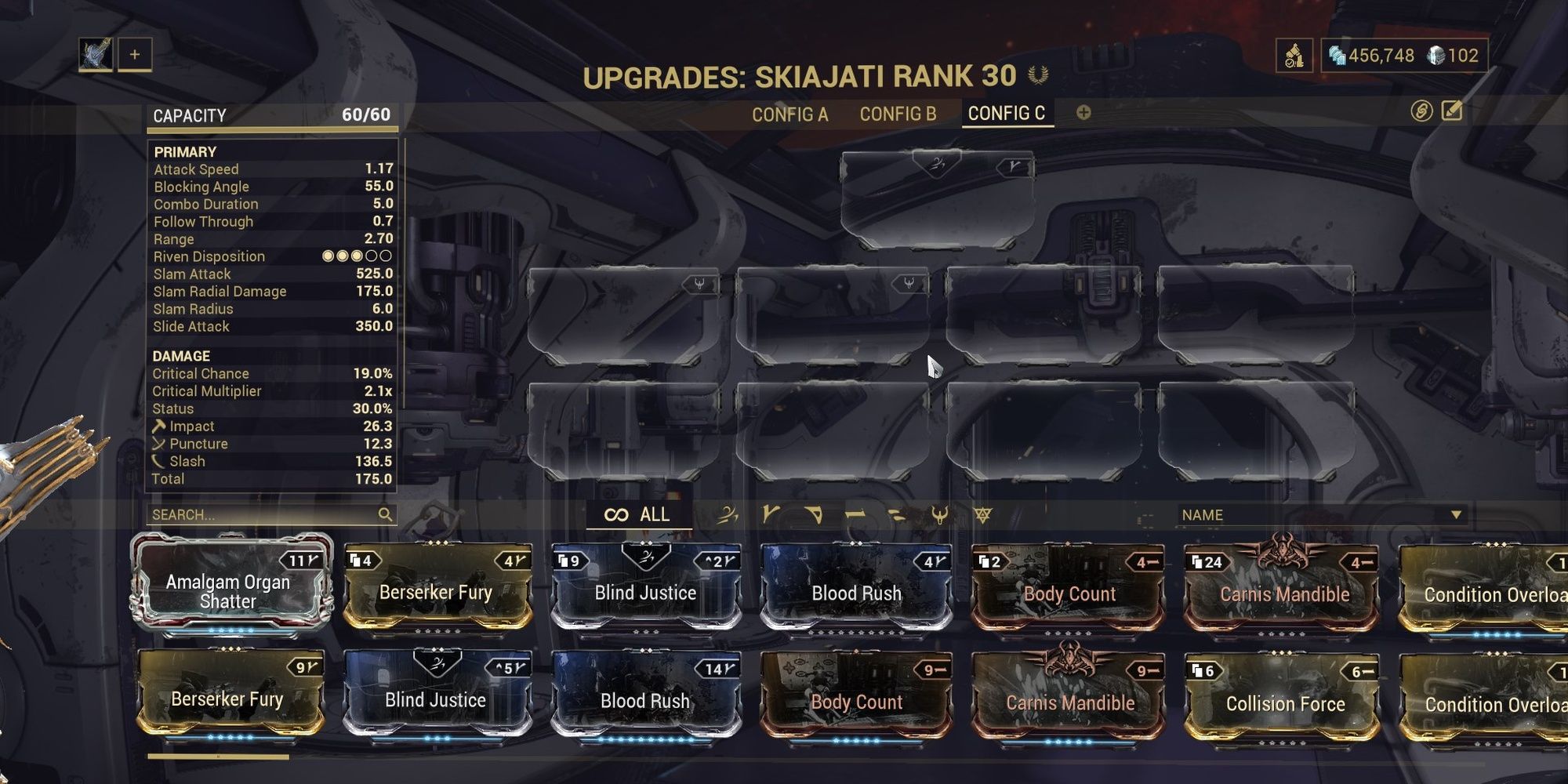
| Stance Slot | |||
| Default Slot | Default Slot | Default Slot | Default Slot |
| Default Slot | Default Slot | Default Slot | Default Slot |
- Stance Slot – Allows you to apply a Stance onto your melee weapon, unlocking new melee combos. Like Aura Mods, Stances give Mod capacity.
- Default Slot – Slots all non-Stance melee Mods.
Melee weapons work just like weapons but with one key difference: they have Stance slots instead of an Exilus slot. Stances are Mods that unlock melee combos for your melee weapon. And just like Aura Mods, Stances increase your melee weapon's Mod capacity. This generally means Melee weapons require less Forma to min-max than a traditional gun.
Melee Stats
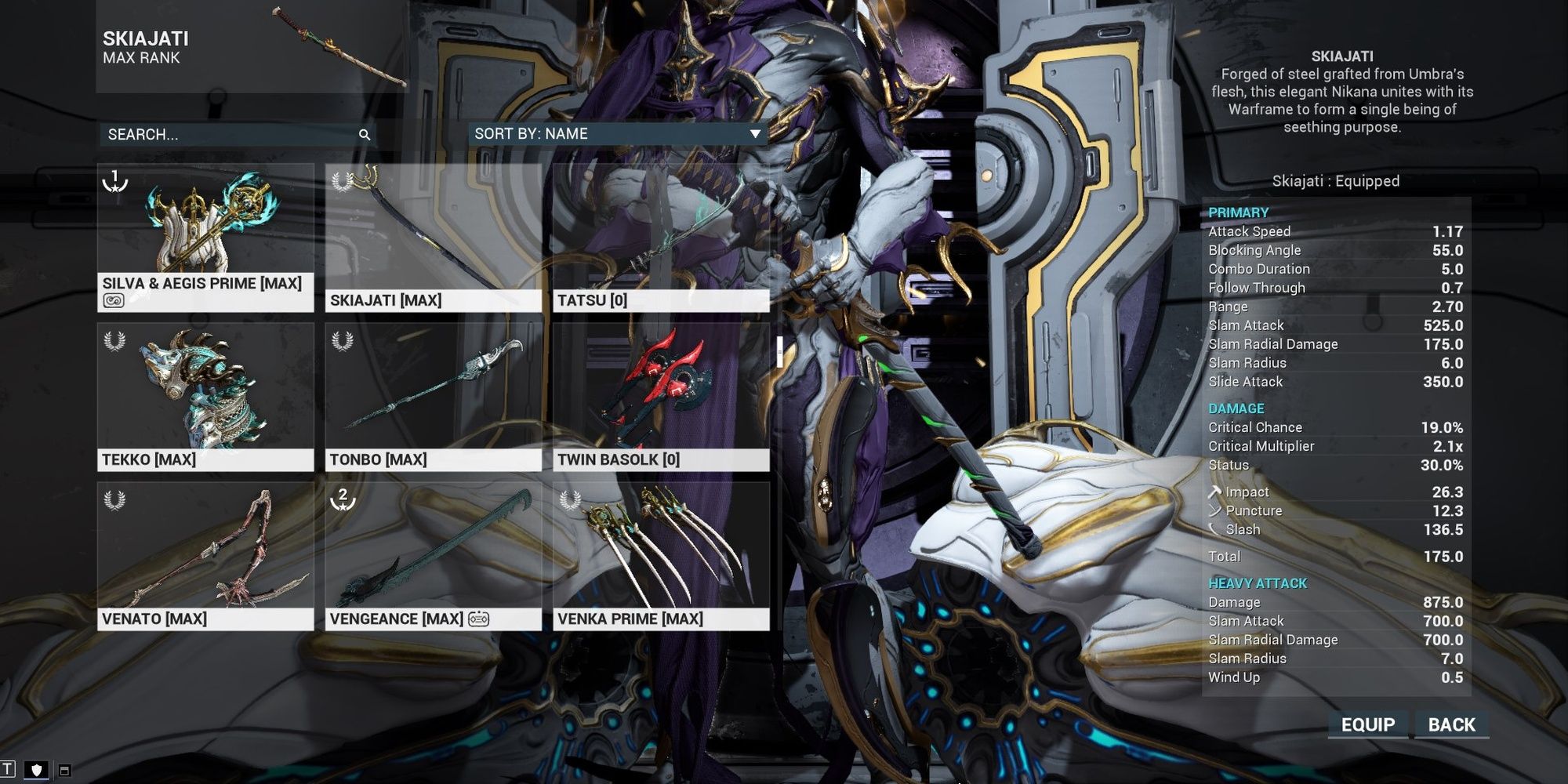
Melee stats are broken up into primary and damage stats. Damage stats are the same as your main weapons, but a melee's primary stats are quite different.
- Attack Speed – How quickly you can attack with your melee each second.
- Blocking Angle – When someone attacks you from the front, you prevent hat attack from dealing damage. This determines the angle from which you can block attacks.
- Combo Duration – Hitting enemies builds up a combo. This determines how long the combo lasts before it completely expires.
- Follow Through – Determines how much damage subsequent targets take from a single swing.
- Range – Affects the length of your melee weapon while attacking.
- Slam Attack – A melee input mid-air while facing the ground will cause you to perform a slam attack. This determines its damage.
- Slam Radial Damage – Determines a slam attack's AoE damage.
- Slam Radius – Determines a slam attack's AoE coverage.
There's also a secondary stat section dedicated to Heavy Attacks. Heavy Attacks consume all of your combo counter to unleash a devastating attack with higher base damage that's multiplied by your combo counter. Certain Mods only impact your Heavy Attack, and some Mods scale based on how high your combo counter is. For nearly every melee weapon in Warframe, your maximum combo counter is x12, achieved with 240 melee hits.
Damage stats are the same for melee weapons as they are for guns:
- Critical Chance – How often this weapon inflicts a critical hit, applying your weapon's critical multiplier to the shot.
- Critical Multiplier – How much harder your bullets hit when they critically hit.
- Status / Projectile – The chance each projectile activates a status effect from one of your damage types. Harder-hitting damage types are more likely to trigger their respective status effect.
- Total – The total damage of each shot.
Consult our damage types explained guide for information on what each damage type does and how it affects your weapon's overall DPS. Like weapons, you want to spec for base damage, add two elemental Mods to create Corrosive or Viral, then scale your attack speed.
Return to Quick Links
Mod Rarities And Types
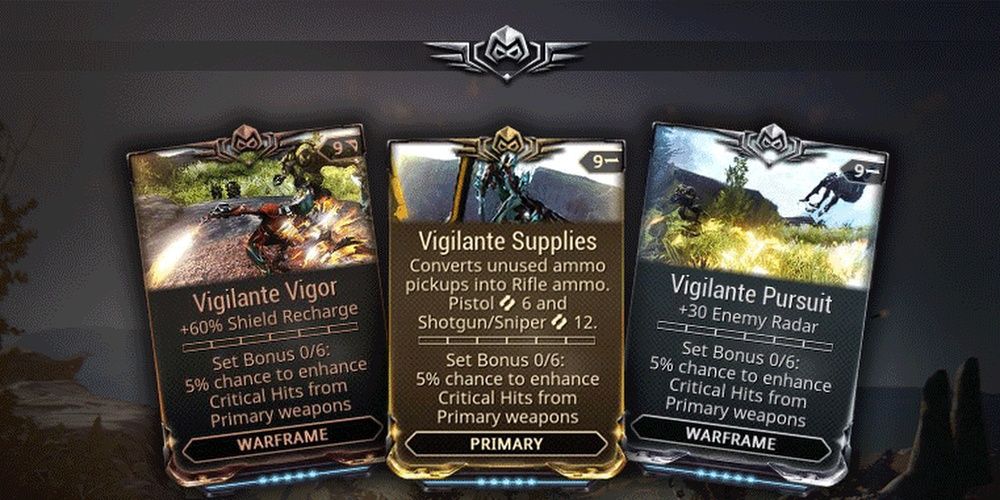
Mods have rarities and categories associated with them. There are quite a few different types of Mods in Warframes that can get incredibly confusing if you're newer. Each rarity and Mod type can be found below.
While they don't fall into specific rarities, there are three other Mod types that deserve to be mentioned: Corrupted Mods, Augment Mods, and Set Mods.
Corrupted Mods are obtained from the Derelict mission in Deimos and grant a powerful positive trait with some sort of downside. Upgrading these Mods will increase the positive and negative attributes the Mod possesses.
Augment Mods are exclusive to Warframes and alter how a Warframe's ability work, adding additional functionality or overhauling how it works. Augment Mods are obtained from Sydnciate vendors.
Set Mods are standard Mods that fit under a set umbrella. Equipping a Mod from a set will grant an additional benefit that scales with how many Mods from the same set you have installed. We cover every Set Mod in our Set Mods tier list.
Return to Quick Links
Transmutation
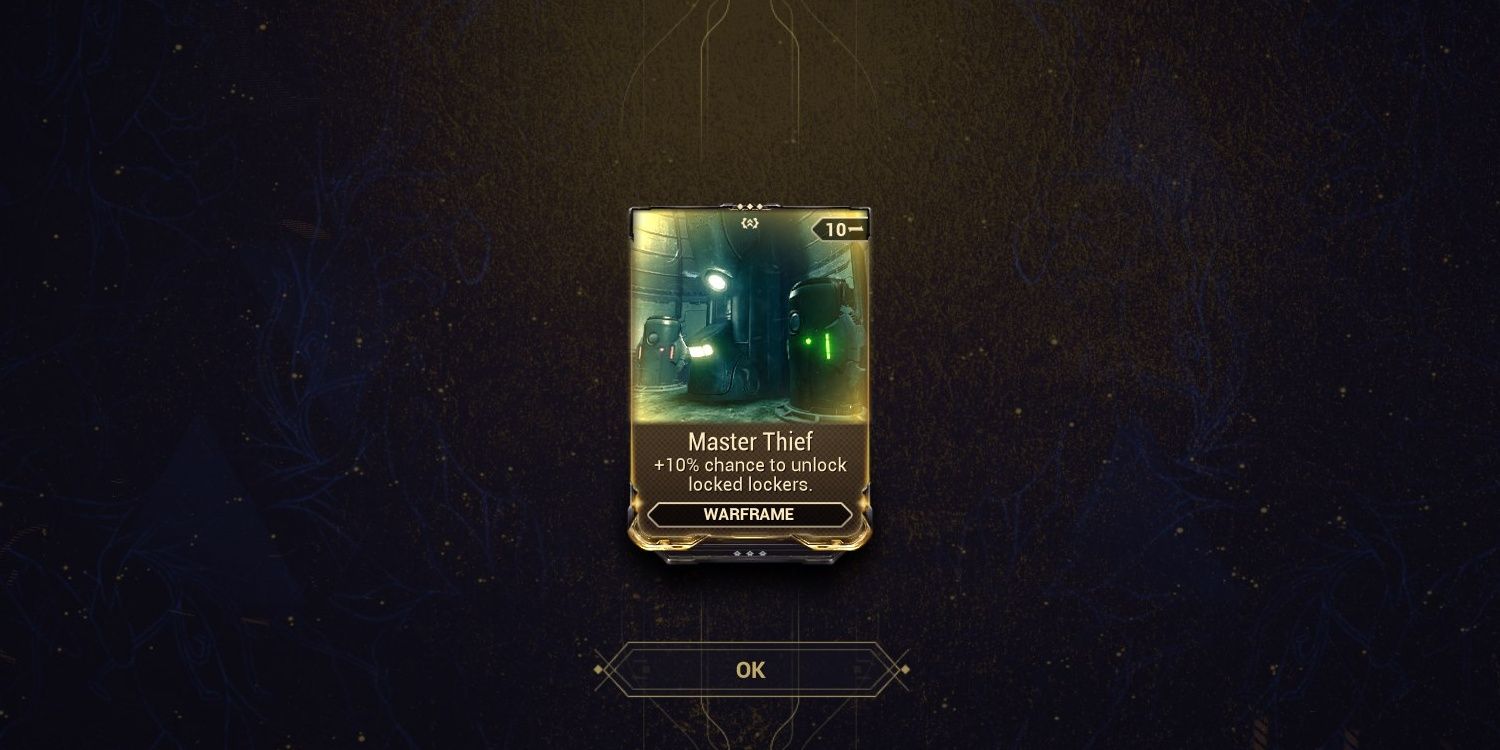
If you're ever swimming in hundreds of duplicate Mods and don't want to dissolve them for resources, you can Transmute them. Transmutation is the process of merging four Mods into a single Mod. The Mod you get from this process is mostly random, and each Transmutation you attempt will incur a small Credit fee.
There are three ways to influence what a Transmutation gives you:
- Match the Polarity of all four Mods you're transmuting. This impacts the odds of getting a transmuted Mod with the same Polarity.
- Match the rarity of all four Mods you're transmuting. This impacts the chances of getting a transmuted Mod with a matching rarity.
- Use a Transmutation Core from Cephalon Simaris. This guarantees that your transmuted Mod will drop with a certain Polarity.
You can transmute most Common, Uncommon, and Rare Mods in Warframe. It's possible to transmute Riven Mods, although that requires a rare item that drops from Eidolons. You cannot transmute Legendary Mods under any circumstances.
Return to Quick Links
Mandatory Mods

Some Mods in Warframe are so commonly used that the community refers to them as "mandatory" or "essential" to making builds. We're going to list off some of Warframe's most widely-considered mandatory Mods to give you an idea of what Mods you'll want to obtain starting out or when you reach the endgame.
New Player Mandatory Mods
There are quite a few Mods in this category, most of which are fixed variants of the flawed Mods you get from the Vor's Prize introductory quest. You'll want to get your hands on the following as soon as possible:
Warframe Mods
| Intensify | +30% Ability Strength |
| Streamline | +30% Ability Efficiency |
| Fleeting Expertise | +60% Ability Efficiency, -60% Duration |
| Continuity | +30% Ability Duration |
| Augur Message | 24% Ability Duration |
| Stretch | 45% Ability Range |
| Flow | +150% Energy Max |
| Redirection | +440% Shields |
| Vitality | +440% Health |
Weapon Mods
Serration(Primary) | +165% Damage |
Hornet Strike(Secondary) | +220% Damage |
Point Blank(Shotgun) | +90% Damage |
Split Chamber(Primary) | +90% Multishot |
Barrel Diffusion(Secondary) | +120% Multishot |
Hell's Chamber(Shotgun) | +120% Multishot |
Pressure Point(Melee) | +120% Damage |
Fury(Melee) | +30% Attack Speed |
*Quickening(Melee) | +40% Attack Speed, 20% Additional Combo Counter |
**Elemental Damage Mods(All) | +90% Cold, Electricity, Heat, or Toxin. |
*This is somewhat rare; you'll need to buy or farm this one.
**You get a few from Junctions, but you'll need to farm or trade to get all of them for each weapon archetype.
Companion Mods
| Animal Instinct | Grants 25m of enemy radar and 15m of loot radar. |
| Fetch | Allows animal companions to vacuum nearby loot to your Warframe. |
| Vacuum | Allows Sentinel companions to vacuum nearby loot to your Warframe. |
Besides Quickening and Fleeting Expertise, just about every Mod listed above can be obtained by trading with other players. Hop into trade chat and ask for some of these Mods. Most veteran players will be more than happy to give these Mods to you for free. If you'd rather farm them yourself, head to the Warframe Fandom Wiki to find their drop locations.
Note: You must be Mastery Rank 2 or higher and have two-factor authentication enabled to trade with other players.
Return to Quick Links
Endgame Mandatory Mods
These Mods are a long-term pursuit and shouldn't be focused on when starting out.
| Mods | Specific Mods | Notes |
|---|---|---|
| Corrupted Mods | Blind Rage, Narrow Minded, Transient Fortitude, Critical Deceleration, and Fleeting Expertise | Obtained from the Deimos Derelict tileset inside of Vaults. |
| Nightmare Mods | Lethal Torrent, Drifting Contact, and Blaze | Clear all the nodes on a planet to access Nightmare Mode. |
| Primed Mods | Primed Continuity, Flow, Pistol Gambit, Target Cracker, Pressure Point, Sure Footed, and Fury | Primed Sure Footed and Fury are login rewards that cannot be traded; they're time-gated. |
| Galvanized Mods | All of them | These can be purchased with Vitus Essence, rewarded by completing Arbitrations. They're stronger variants of popular mandatory Mods. |
| Umbral Mods | All of them | Complete "The Sacrifice" quest to obtain these Mods. |
| Drift Mods | Power Drift and Cunning Drift | These are the only Exilus Mods that boost Warframe ability stats. |
Return to Quick Links
Source: https://www.thegamer.com/warframe-modding-beginners-guide/
0 Response to "Mods to Transmute Into Continuity Warframe"
Post a Comment